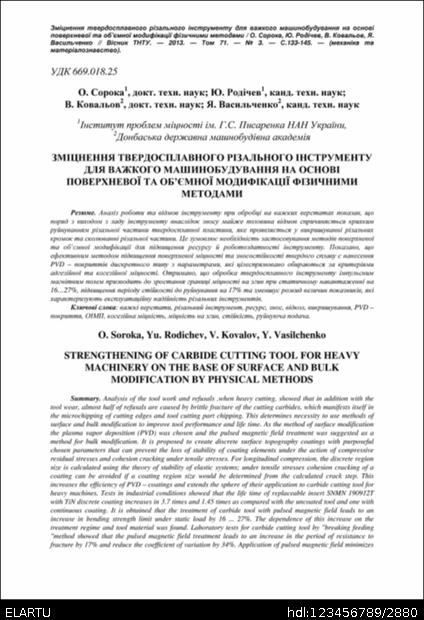Ezzel az azonosítóval hivatkozhat erre a dokumentumra forrásmegjelölésben vagy hiperhivatkozás esetén:
http://elartu.tntu.edu.ua/handle/123456789/2880

Összes dokumentumadat
| DC mező | Érték | Nyelv |
|---|---|---|
| dc.contributor.author | Сорока, О. | - |
| dc.contributor.author | Родічев, Ю.Я. | - |
| dc.contributor.author | Ковальов, В. | - |
| dc.contributor.author | Васильченко, Я. | - |
| dc.contributor.author | Soroka, O. | - |
| dc.contributor.author | Rodichev, Yu. | - |
| dc.contributor.author | Kovalov, V. | - |
| dc.contributor.author | Vasilchenko, Y. | - |
| dc.date.accessioned | 2014-02-24T10:36:13Z | - |
| dc.date.available | 2014-02-24T10:36:13Z | - |
| dc.date.issued | 2013-08-01 | - |
| dc.identifier.citation | Зміцнення твердосплавного різального інструменту для важкого машинобудування на основі поверхневої та об’ємної модифікації фізичними методами / О. Сорока, Ю. Родічев, В. Ковальов, Я. Васильченко // Вісник ТНТУ. — 2013. — Том 71. — № 3. — С.133-145. — (механіка та матеріалознавство). | uk |
| dc.identifier.issn | 1727-7108 | - |
| dc.identifier.uri | http://elartu.tntu.edu.ua/handle/123456789/2880 | - |
| dc.description.abstract | Аналіз роботи та відмов інструменту при обробці на важких верстатах показав, що поряд з виходом з ладу інструменту внаслідок зносу майже половина відмов спричиняється крихким руйнуванням різальної частини твердосплавної пластини, яке проявляється у викришуванні різальних кромок та сколюванні різальної частини. Це зумовлює необхідність застосовування методів поверхневої та об’ємної модифікації для підвищення ресурсу й роботоздатності інструменту. Показано, що ефективним методом підвищення поверхневої міцності та зносостійкості твердого сплаву є нанесення PVD – покриттів дискретного типу з параметрами, які цілеспрямовано обираються за критеріями адгезійної та когезійної міцності. Отримано, що обробка твердосплавного інструменту імпульсним магнітним полем призводить до зростання границі міцності на згин при статичному навантаженні на 16…27%, підвищення періоду стійкості до руйнування на 17% та зменшує розкид величин показників, які характеризують експлуатаційну надійність різальних інструментів. | uk |
| dc.description.abstract | Analysis of the tool work and refusals ,when heavy cutting, showed that in addition with the tool wear, almost half of refusals are caused by brittle fracture of the cutting carbides, which manifests itself in the microchipping of cutting edges and tool cutting part chipping. This determines necessity to use methods of surface and bulk modification to improve tool performance and life time. As the method of surface modification the plasma vapor deposition (PVD) was chosen and the pulsed magnetic field treatment was suggested as a method for bulk modification. It is proposed to create discrete surface topography coatings with purposeful chosen parameters that can prevent the loss of stability of coating elements under the action of compressive residual stresses and cohesion cracking under tensile stresses. For longitudinal compression, the discrete region size is calculated using the theory of stability of elastic systems; under tensile stresses сohesion cracking of a coating can be avoided if a coating region size would be determined from the calculated crack step. This increases the efficiency of PVD – coatings and extends the sphere of their application to carbide cutting tool for heavy machines. Tests in industrial conditions showed that the life time of replaceable insert SNMN 190912T with TiN discrete coating increases in 3.7 times and 1.45 times as compared with the uncoated tool and one with continuous coating. It is obtained that the treatment of carbide tool with pulsed magnetic field leads to an increase in bending strength limit under static load by 16 ... 27%. The dependence of this increase on the treatment regime and tool material was found. Laboratory tests for carbide cutting tool by "breaking feeding "method showed that the pulsed magnetic field treatment leads to an increase in the period of resistance to fracture by 17% and reduce the coefficient of variation by 34%. Application of pulsed magnetic field minimizes scatter values of indicators characterizing operational reliability of cutting tool. It is concluded that promising methods to improve tool performance and life time are techniques that combine surface and bulk modification. | uk |
| dc.language.iso | uk | uk |
| dc.publisher | Тернопільський національний технічний університет ім. Івана Пулюя | uk |
| dc.subject | важкі верстати | uk |
| dc.subject | різальний інструмент | uk |
| dc.subject | ресурс | uk |
| dc.subject | знос | uk |
| dc.subject | відкол | uk |
| dc.subject | викришування | uk |
| dc.subject | PVD – покриття | uk |
| dc.subject | ОІМП | uk |
| dc.subject | когезійна міцність | uk |
| dc.subject | міцність на згин | uk |
| dc.subject | стійкість | uk |
| dc.subject | руйнуюча подача | uk |
| dc.subject | heavy machine | uk |
| dc.subject | cutting tool | uk |
| dc.subject | life time | uk |
| dc.subject | wear | uk |
| dc.subject | chip | uk |
| dc.subject | microchipping | uk |
| dc.subject | PVD – coating | uk |
| dc.subject | cohesive strength | uk |
| dc.subject | pulsed magnetic field treatment | uk |
| dc.subject | bending strength | uk |
| dc.subject | resistance | uk |
| dc.subject | breaking feeding | uk |
| dc.title | Зміцнення твердосплавного різального інструменту для важкого машинобудування на основі поверхневої та об’ємної модифікації фізичними методами | uk |
| dc.title.alternative | Strengthening of carbide cutting tool for heavy machinery on the base of surface and bulk modification by physical methods | uk |
| dc.type | Article | uk |
| dc.rights.holder | © „Вісник Тернопільського національного технічного університету“ | uk |
| dc.coverage.placename | Тернопіль, Україна | uk |
| dc.status | Опубліковано раніше | uk |
| dc.subject.udc | 669.018.25 | uk |
| Ebben a gyűjteményben: | Вісник ТНТУ, 2013, № 3 (71) | |
Fájlok a dokumentumban:
Minden dokumentum, ami a DSpace rendszerben szerepel, szerzői jogokkal védett. Minden jog fenntartva!